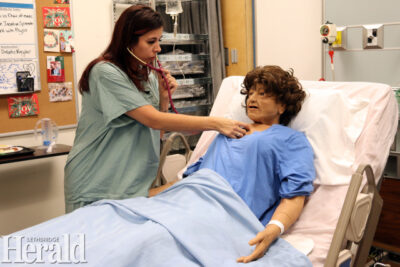Simulation hub offers immersive learning experience for students
By Lethbridge Herald on January 21, 2025.
 Simulation specialist Rhonda Mann demonstrates how students are able to utilize the high-fidelity mannequins in the Simulation Hub in the Centre for Health and Wellness, on Tuesday at Lethbridge Polytechnic.
Herald photo by Alejandra Pulido-Guzman
Simulation specialist Rhonda Mann demonstrates how students are able to utilize the high-fidelity mannequins in the Simulation Hub in the Centre for Health and Wellness, on Tuesday at Lethbridge Polytechnic.
Herald photo by Alejandra Pulido-GuzmanAlejandra Pulido-Guzman – LETHBRIDGE HERALD – apulido@lethbridgeherald.com
Hands on learning has been taken to a whole new level at Lethbridge Polytechnic thanks to the Simulation Hub at the Centre for Health and Wellness, which is now internationally accredited.
The Simulation Hub is accredited by the Society for Simulation in Healthcare (SSH), making Lethbridge Polytechnic one of four post-secondary institutions in Canada to achieve such accreditation.
Marie Laenen, a simulation instructor at Lethbridge Polytechnic says their simulation area is quite unique compared to a lot of simulation centres throughout Canada.
“One of the reasons it is unique is because we use a high degree of realism-based education. We use a lot of actors, and we also have our high-fidelity mannequins that are very lifelike,” says Laenen.
She explains that the mannequins have heartbeats, they can breathe, they can cry, and they can talk.
“But what makes us unique is how much collaboration we do between programs. If you are a nursing student, you’re going to be collaborating with our paramedic program students and you may be collaborating with our policing programs,” says Laenen.
She says they integrate multiple programs to prepare students for the future as they will most likely be working alongside other health care providers and first responders.
“I think students really benefit from the immersive learning of hands on. We rarely learn just from hearing it or reading it in a textbook, especially for frontline workers, as we tend to be hands-on learners,” says Laenen.
The Simulation Hub not only allows students to learn practical skills hands-on, but also allows them to be immersed in different scenarios that they may encounter in real life.
“I think it’s really important because we’re going to go out to very uncomfortable situations that are a reality in our community and if we can work on those approaches here, to make sure that everybody is treating people with dignity and respect in the education system, it’s easier when they get out there and it’s already been modelled here,” says Laenen.
She adds that another benefit of the simulated scenarios is that the realism brings the emotion in, which helps them prepared on a different level and it also serves as a bigger buy-in with students because it feels real.
Gloria Okbara, a student that has benefitted from using the Simulation Hub says the realistic hand-on scenarios are very helpful for her learning.
“It makes it very real. If you don’t have a real human being to work with, it makes it very real. We don’t look at the mannequins as mannequins, we see them as our patients because we can talk to them and interact with them,” says Okbara.
She says being able to learn with realistic case scenarios is very helpful, because once she gets to real life it will be easier to handle various situations because she has practice them at school.
Fred Manaloto, a simulation specialist explains that in order to recreate realistic scenarios he consults with various professionals in various fields, to make sure the simulations are on par with what students will encounter once they are out in the workforce.
“We collaborate with different health care professionals in the community. We work with real paramedics and police for example, to make sure that we are in line with the scopes of practice, and we don’t go beyond what the students are required to do,” says Manaloto.
He says one of the benefits of realistic scenarios is that it helps students get over the shock factor of really bad scenarios and they are able to react quickly and accurately because they have practice in a safe space during their training at Lethbridge Polytechnic.
“For example, in our simulation we have the high-fidelity mannequin, but we add details like an actual phone which they can use to call the doctor instead of just verbalizing ‘I’m calling the doctor,’ because that skill alone of picking up the phone and talking to a doctor as a student is really frightening sometimes,” says Manaloto.
20-19


